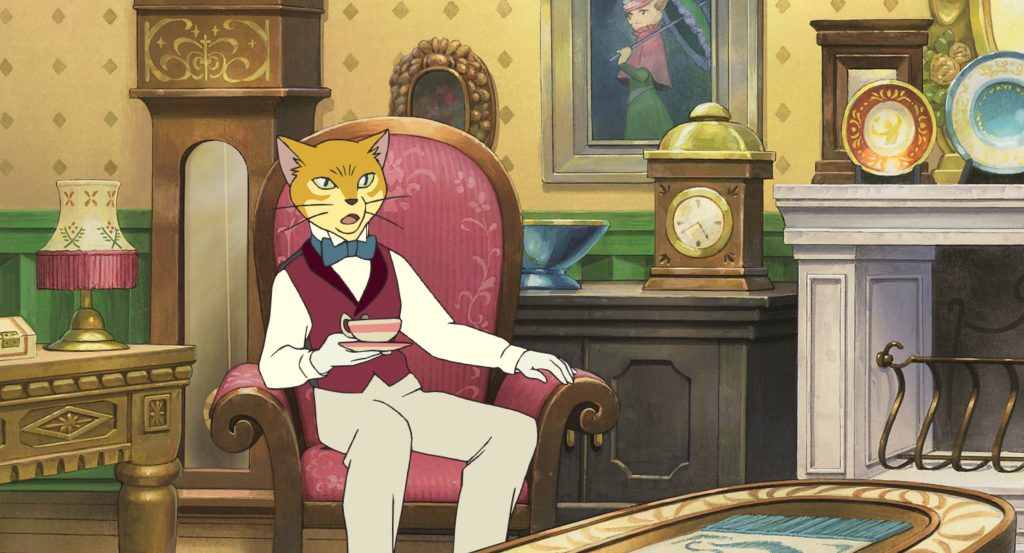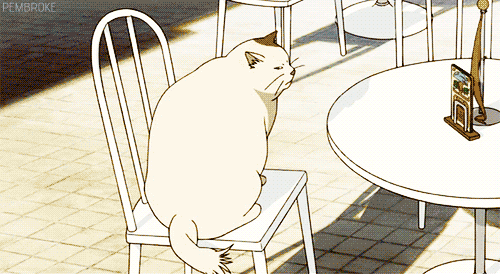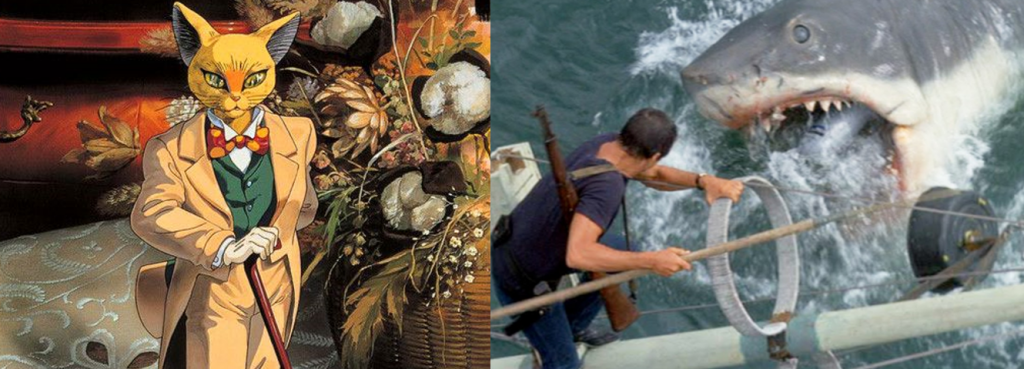
The Cat Returns (2002) is a Japanese fantasy film animated by Studio Ghibli, which follows dissatisfied schoolgirl Haru Yoshioka, who after saving a cat from a road collision, discovers she has the ability to talk to cats. Upon saving the feline it is revealed that this individual is none other than Prince Lune, Heir to the Cat Kingdom. Gifts are showered upon Haru from the kingdom in thanks and an arranged marriage is proposed between Haru and the Prince. Hesitant to accept this union, Haru seeks the help of the Cat Bureau, where she encounters Muta, Toto and the Baron, who embark on a journey to rescue Haru from the Cat Kingdom and free her from a life of cat-hood.
Due to its characterisation as an animation, The Cat Returns is able to explore a variety of animal representations without a focus on realism. Fantastical representations of animals including cats inhabiting their own kingdom and arranging marriages is possible due to the premise of animated films as fantasy stories. The concept of anthropomorphism is also commonly explored and accepted within animation, and The Cat Returns conforms to this expected trait. The cats of the Cat Kingdom’s ability to speak therefore becomes unsurprising to the audience due to the familiar trait of the genre. The Cat Returns however, uses anthropomorphism and animalisation in a more intricate manner to depict a duality between the reality of feline behaviours and the human interpretation of the characteristics of the cat. The film contrasts the real cats of the Cat Kingdom against The Baron to demonstrate how we project human characteristics and emotions onto animals, many of which differ from that of our factual and scientific understanding of their behaviours. The contrast between these two portrayals demonstrates the difficulties of determining the true characteristics of the cat and the problems that arise when they are misinterpreted.

The film uses the characterisation of The Baron to display how human assumptions and interpretations of animals are regarded as factual and become the social norm. Baron Humbert von Gikkingen is a figurine created by an artisan, who gave The Baron a soul and the ability to live through creating him with ‘all of his heart’. Despite The Baron being a statue, he is nevertheless a cat. He is however, a cat fabricated from the image of what his human creator defines a cat to be and as a result displays a significant contrast of character and behaviour to that of the real cats within the film.

Firstly, The Baron possesses more anthropomorphic qualities than rest of the cats in the cat kingdom, despite their ability to speak. The Baron is separated from the other cats through his wearing of clothes and the refined manner by which he presents himself. The Baron’s fashion and mannerisms reflect that of the Victorian dandy; he is suave, sophisticated and charms Haru through his bravery and sense of justice. Accompanying these more human characteristics, The Baron also depicts characteristics more evident of our social symbolism of the cat. He is confident, independent and reflects the less factual interpretations of the cat as an animal totem. Many believe that the cat has significant symbolism in its communication style “labelling it as the bridge to the spirit world, the connection between the seen and the unseen”[1]. This is exactly what The Baron comes to represent in The Cat Returns, he is Haru’s link between her familiar human world and the hidden realm of cats and the Cat Bureau, “the refuge for all creations”.
Unlike The Baron, other cats within The Cat Returns reflect a more realistic and factual representation of the cat. The common cats of the human world meow, growl and exhibit hunting behaviours, evident in the scene where many cats flock to claim mice as they fall from Haru’s locker. Whilst the concept of cats chasing mice may appear cliché, it is nonetheless a factual trait that can be supported from our observation of both domestic and feral cats.

Muta is another key instance of a cat from the Cat Kingdom that as a whole possesses more evident cat like qualities. Despite possessing the anthropomorphic quality of speech, Muta becomes an example of animalisation that is more positive through the reflection of accurate cat-like traits. Muta’s physical appearance is more identifiably feline; he has paws (unlike The Baron who has hands) and is one of the few cats within the film seen walking on all fours.

Although The Baron may exert some characteristics of the cat, these characteristics are assumptions based on the personality and spiritual meaning of the cat. These elements are not based on factual information and cannot be seen though observation of a cat’s behaviour. This issue therefore becomes significant in The Cat Returns as the portrayal of these two very alternate depictions of the cat demonstrates the difficulty in determining the definitive characteristics of the animal.
The confusion that arises as a result of this is evident in Haru and her misinterpretation of the cat after being exposed to The Baron. Haru is constantly drawn in by the “cool” allure of The Baron which manifests itself in his refined nature, compassion and style. Haru admits she has a “little crush” on The Baron and assumes that the other cats of the Cat Kingdom must be the same as a him as a result of the attention and gifts she receives from them. This is unfortunately not the case and Haru’s attraction to The Baron stems from her admiration of his human characteristics, which she mistakenly interprets for those of the cat.
As a result of her assumptions, Haru places herself in immense danger as she enters the Cat Kingdom, allowing herself to be manipulated by the cats under the pretence that they will treat her with kindness and respect much like The Baron. From the very beginning, Haru is too accepting towards the cats, she doesn’t understand or acknowledge the divide between animals and humans and is willing to break this barrier through an animal- human marriage. The more Haru begins to trust the Cat Kingdom the more she loses the clarity and certainty of her human self, slowly transforming into a cat as she merges humanity and cat-hood together. Haru’s attraction to The Baron clouds her judgement and causes her to generalise the entirety of the cat species. This generalisation subsequently results in her imprisoned in the Cat Kingdom from which she must be rescued by Muta and The Baron.

Though the danger that arises as a result of Haru’s actions cannot be translated to real life, the message regarding the importance of animal classification nonetheless remains clear. The Cat Returns encourages the audience to think carefully about how we interpret animals and the difficulties that can arise as a result of misinterpretation.
Projecting human characteristics and cultural beliefs onto animals often has an adverse effect on how animals are received. Whilst The Cat Returns explores many unrealistic dangers of misinterpretation, the human attributes projected onto The Baron and the challenges that ensue as a result of them reflect the same problems evident within our own society. Black cats for example become a key indicator of how assigning human attributes to animals produces such negative effects. Within western culture black cats have the superstitious connotations of bad luck, witchcraft and evil which have followed them for centuries. These traits mean that the black cat is ostracised and statistically proven to be the least adopted and most frequently neglected cat. In the fourteenth century humans even resulted to a mass killing of these cats because of the superstitious beliefs against them[2]. The depiction of The Baron as a manifestation of human ideas cleverly draws upon these issues and encourages the audience to reflect upon how our interpretation of cat behaviours and their symbolism can result in a negative treatment towards them. Much like The Baron’s image being a fictional fabrication, what causes society to mistreat the black cat is an attribute fabricated from religious superstition and one that has no factual or scientific significance. The Cat Returns acts to criticise these cultural assumptions towards animals through actively punishing Haru for exhibiting these same behaviours, trapping her in the Cat Kingdom. The longer Haru is in the kingdom the deeper her transformation into a cat becomes. Through this transformation Haru is brought down to the level of the cat and is forced to evaluate the real behaviours and attributes of the cat from their perspective.

Whilst films such as The Cat Returns highlight cultural aspects and perceptions of animals, they also have the power to change the way we think about animals. Films have the ability to influence cultural perceptions of animals the same way religious beliefs influenced the superstitions and myths towards the black cat that became the cultural norm. The 1975 blockbuster Jaws is considered one of the most significant films that altered social perceptions of the animal. At first glance, Steven Spielberg’s shark flick may not seem relevant to the children’s fantasy of The Cat Returns, but both films are significant in illuminating the effects of a singular interpretation of an animal on the entirety of a species. Spielberg’s depiction of the great white as a bloodthirsty man-eating machine sparked widespread fear of sharks and resulted in the mass fishing of sharks which in turn dramatically decreased the shark population. The film’s exploration of one man’s vision changing the human perception of the shark links closely to the creation of The Baron and how the creator’s individual vision of the cat alters Haru’s perception of the species as a whole.

The definitive message of The Cat Returns is not explicitly related to human-animal relationships but does however become significant when analysing animals within the text. The ultimate message that the film is trying to teach the audience is that you must “trust yourself”; trust your own decisions and have confidence in what you believe in. Haru’s journey through the Cat Kingdom signifies this belief, with the realisation that she “wasn’t wrong to save a cat […] I believe in my decision”. With this logic and message in mind, the certainty and confidence in what you believe then extents to your beliefs towards animals. The audience are encouraged to have a certainty regarding their understanding of animals and acknowledge the difference between human characteristics projected onto animals and the true characteristics of animals. Haru’s realisation that not all cats are the same acts as the example to follow within this film. Only when Haru has certainty of mind and confidence of her understanding of cats after immersing herself in the cat world, is she then allowed to return to her human world.
To conclude and summarise, The Cat Returns uses The Baron as the main method of demonstrating the importance of representing animals accurately and the difficulties that arise when human characteristics are associated with an animal. The anthropomorphism of The Baron is contrasted with the animalised cats of the Cat Kingdom to educate the audience on the differences between the real and factual characteristics of the cat and the inaccurate and fabricated human portrayal. Witnessing the difficulties and dangers Haru faces as a result of her misunderstandings allows The Cat Returns to draw upon social issues regarding the mistreatment and marginalisation of certain species. The film encourages the audience to reflect upon the power cultural and religious influences have over our approach towards animals and how these influences in turn have negative effects on animals themselves.
References
Bostwick, Leah M, Cat Totem – Does This Symbol Mean Good Luck? (2019) <https://www.sunsigns.org/cat-animal-totem-symbolism-meanings/> [accessed 9 January 2019].
Crockett, Zachary, Why Don’t People Adopt Black Pets? (2019) <https://priceonomics.com/why-dont-people-adopt-black-pets/> [accessed 9 January 2019].
Ewing, James Blake, THE CAT RETURNS (2002) (2019) <https://creativecriticism.net/?p=15794> [accessed 7 January 2019].
Runyon, Christopher, The Studio Ghibli Retrospective: “The Cat Returns” (2017) <http://moviemezzanine.com/studio-ghibli-retrospective-the-cat-returns/> [accessed 9 January 2019].
[1] Leah M Bostwick, Cat Totem – Does This Symbol Mean Good Luck? (2019) <https://www.sunsigns.org/cat-animal-totem-symbolism-meanings/> [accessed 9 January 2019].
[2] Zachary Crockett, Why Don’t People Adopt Black Pets? (2019) <https://priceonomics.com/why-dont-people-adopt-black-pets/> [accessed 9 January 2019].